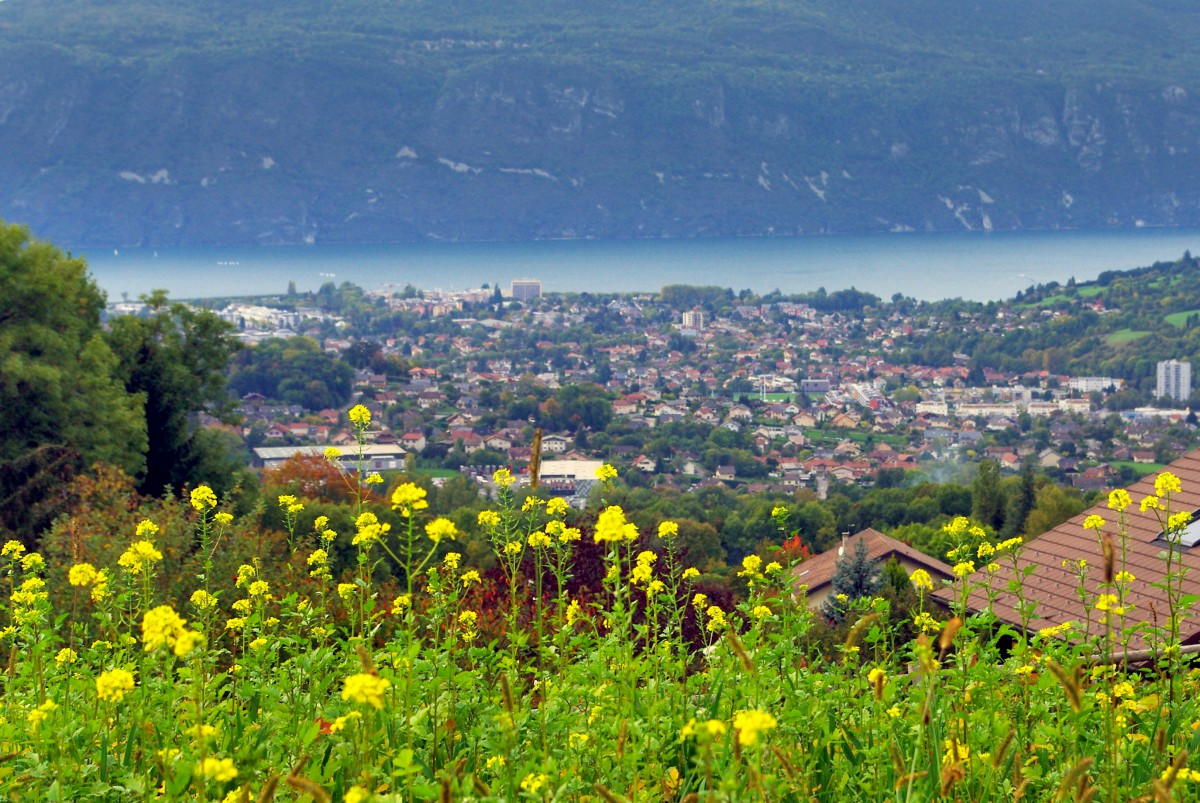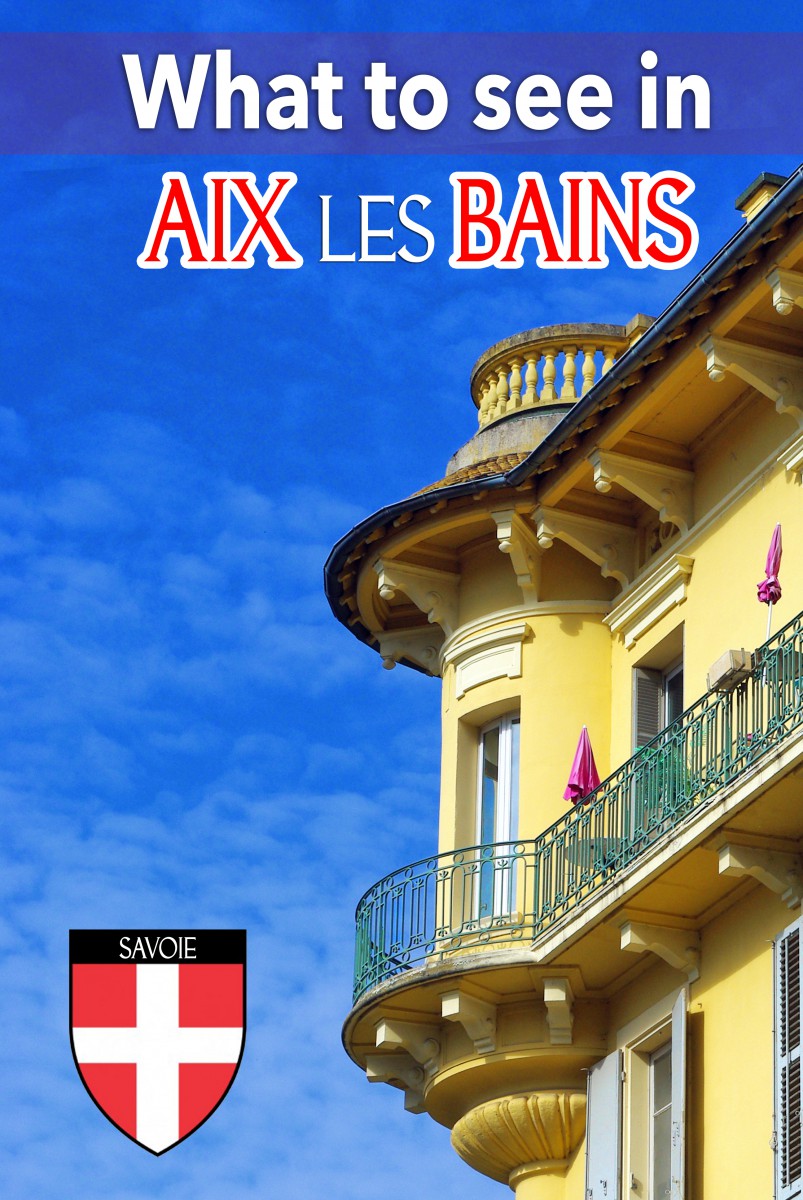Aix-les-Bains is a spa resort in the French département of Savoie between Annecy and Chambéry in the French Alps. Bordered by Lake Bourget, the town enjoys a beautiful spot surrounded by spectacular mountains. On my last visit to Aix-les-Bains, I was impressed by the elegant houses from the Belle Époque era. You’ll find below the itinerary I followed in the town centre.
Why you should stop at Aix-les-Bains

Aix-les-Bains (pop. 28,500) is ideally situated between two spectacular mountains: the Revard and the Mont du Chat. The town is part of the province of Savoie and is bordered by one of France’s purest lakes: Lac du Bourget. Aix enjoys a micro-climate which is why you might be surprised to see lush Mediterranean vegetation here and there, from palm trees in front of the Casino to lavender and olive trees in the gardens of exclusive private mansions. While strolling in the town centre, you’ll probably feel (like I did) a kind of Italian feel. The railings of the balconies and the pastel façades did remind me of Italy… after all this is not too surprising considering that before 1860 Aix and Savoie were part of the Italian world!
The waters of Aix have been renowned since Roman times for their healing qualities.
My itinerary to discover Aix-les-Bains

The old town is not very spread out so you should be able to see most of it within half a day. There are covered car parks found near the Town-Hall (Place Maurice Mollard), rue Davat and rue du Casino. Alternatively you can park your car on Place Georges Clemenceau and walk up the shopping street of rue de Genève. This is where I started my discovery walk.
[wpgmza id=”20″]
First, walk up rue de Genève.
Rue de Genève

This is Aix’ main shopping street. You can already spot some fine buildings with elegant balconies that were built in the late 19th century.
Walk straight ahead to Place Carnot.
Place Carnot
The pedestrian square was built on the main road from Geneva to Chambéry. During the Middle-Ages it was situated half-way between the two entrance gates. It is bordered by some fine buildings, including the Hôtel Métropole.
Turn left on rue des Bains and reach place des Thermes.
Place des Thermes and Hôtel Astoria

The lovely fountain at the centre of the place des Thermes is topped by a little statue which was acquired by the municipal council in 1928 from a local antique dealer.
The square is bordered by the prestigious Astoria hotel, built by Swiss architects in 1904-1905. This is the last Grand Hôtel still in operation. The others have been converted into flats since 1945.
Cross the square and go under the Arch of Campanus.
The Arch of Campanus

This is a great testimony of Roman presence in Aix, then known as Aquae (this is similar to Aix-en-Provence and Aix-la-Chapelle or Aachen). The 9.15 m high monument was probably built in the 1st century AD when Romans settled there for the local hot springs. The original purpose of the arch is unknown: it may have been erected as a funerary arch, a triumphal arch, or more likely as a monumental door opening onto the thermal baths.
Go to the old thermal baths and enter the hall.
Old Thermal Baths

This monumental building of the Thermes Pellegrini is one of the two thermal baths that makes the national baths of Aix-les-Bains. Its façade is divided into large bays comprising three windows with round arches. Have a look inside to see the great hall, a superb example of Art Deco.

You will find inside the building the Tourist Information Centre of Aix-les-Bains where you can grab some touristic brochures and ask for general enquiries about the town and its surroundings.
Enter the public gardens of Parc Thermal for a moment of peace and quiet!
Parc Thermal

The beautiful floral park has old and rare trees. In summer, the theatre of greenery welcomes open-air concerts.
Head towards the City-Hall.
The City-Hall

It looks like a castle? Well, it is a castle, dating back to the 15th century. Today it houses the City-Hall of Aix.
Backing the town hall are the remains of a Gallo-Roman temple, known as the Temple de Diane (Temple of Diana). It has been converted into an archaeological museum, the Lapidary museum, which can be visited on a guided tour.
Walk down the square du Temple de Diane where you’ll find some typical French-style cafés. Once on place Carnot, turn left on rue Albert 1er.
Rue Albert 1er

We are back on the old road that connected Geneva to Chambéry in the Middle Ages. In the past it was known as rue de Chambéry… before being renamed in honour to Albert I, king of Belgium for its heroic courage during WWI. I love this narrow street with its boutiques, cafés and restaurants.
The Casino Grand Cercle

This is arguably the most opulent building I’ve seen in Aix. It was first built by Pellegrini in 1850 and inaugurated by Victor-Emmanuel, King of Sardinia-Piedmont and Duke of Savoy… at a time where Aix-les-Bains was not French!

You have to enter in to marvel at the extraordinary Belle Époque-style interior design. This kind of decoration (mosaics, sculptures and glass-windows) would be expected in Paris but maybe not in an average-size town in Provincial France. Let’s remember that Aix welcomed the aristocracy in the 19th century: Queen Victoria (on three occasions), a maharajah from India, the Emperor of Brazil, Empress Elizabeth of Austria-Hungary (the popular “Sissi”).
At the rear of the casino are the Japanese gardens.
The Japanese gardens

This exquisite garden was created in 1998 at the occasion of the Year of Japan in France. It symbolises the friendship between France and Japan.
Walk back to the Place Georges Clemenceau via rue du Casinon and rue de Genève.
How to get to Aix-les-Bains and other tips

- By road – Aix-les-Bains is easily accessible by motorway from: Geneva (A1, 70kms), Annecy (A41, 35kms), Chambéry (A41, 19kms), Grenoble (73kms) and Lyon (113kms). Paris is 575kms away.
- By train – The town is serviced by trains from Chambéry, Annecy, Lyon and Paris (3hr journey).
- If you have time to explore Aix-les-Bains, make sure to visit the Faure Museum set in a Roman-style villa. It contains a fine collection of paintings and sculptures. This is where you’ll admire Rodin’s biggest collection after the Rodin Museum in Paris.
- Also have a look at the former Grand Hotel buildings. Although the luxury palaces have been converted into flats a long time ago, the buildings are still majestic to look at: the Splendide, Excelsior, Bernascon, Beau Site…
- Outside the limits of the town centre, perched on a hill, stands the Château de la Roche du Roi. This is a jewel of the Belle Époque style which is currently under restoration.
- The lake front is worth a visit – but this will be included in another post!
Check out the Tourist Board of Aix-les-Bains (in French only)
Did you find what you read interesting? If so, please do share this article on Facebook or twitter!
Inspired? Pin it for later:







Hello!
I am visiting Aix-les-bains very soon, and I am very concerned about the parking and its rates.
As a foreign tourists, what are my options if I will be staying there for a week if my accommodation does not provide parking? Any information would be helpful, thank you!
Bonjour! I would contact the Tourist Board of Aix-les-Bains by email to get help in parking. Here is the link https://www.aixlesbains-rivieradesalpes.com Have a great stay in Aix, it’s such a beautiful spot in the French Alps!
your site allows one to see the marvels of France. I find it free from influence; other than a love for France that is quite apparent. The fact that your words are your words; not a tourist board or chamber of commerce's selling points is quite refreshing.
Thank you very much for your comment! It is always a pleasure to help people discover France!
Bonjour Pierre,
Visiting French Alpes for the first time, and your site has been the most wonderful resource, kudos to you and a huge thank you for creating all the great content!
Thank you Loretta for your kind comment, it’s always a pleasure! Have a great time visiting the French Alps!